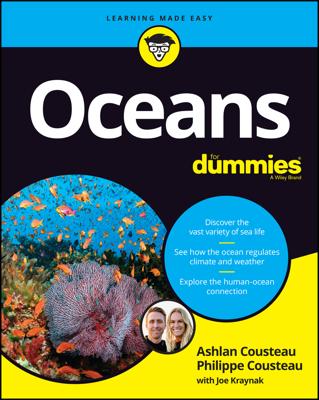Swimming through Kelp Forests
Imagine flying free through a giant forest surrounded by beautiful colors and bizarre, extraordinary animals. That’s what it’s like to swim through a kelp forest. While we may call them kelp forests, kelp is not technically a plant like a tulip or a tree. In fact, kelp is a multi-cellular algae that just looks like a plant. What distinguishes it from a plant is that plants have a vascular system to transport water and nutrients, whereas every cell in kelp is responsible for absorbing its own water and nutrients.Smaller gatherings of kelp are called kelp beds.
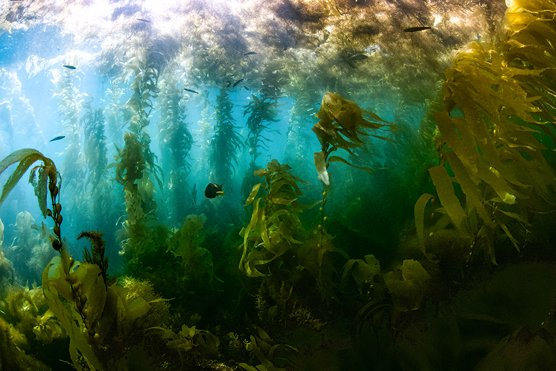 Source: Hal Wells—www.HollywoodDivers.com
Source: Hal Wells—www.HollywoodDivers.comShafts of light stream down through the canopy of a kelp forest off the coast of California.
Kelp thrives in cool/cold (from 42 to 72 degrees Fahrenheit), nutrient rich, and relatively shallow (two to 30 meters or 6 to 100 feet deep) water. It attaches itself to the seafloor with small rootlike structures called haptera or holdfasts. The kelp stays vertical in the water column thanks to gas filled floats (like tiny buoys) at the top of their stipes (comparable to stalks) or where each blade (the leafy part) branches off. Some kelp can grow up to 18 inches per day and reach up to almost 50 meters (150 feet) long.
These underwater forests are high in diversity. Like terrestrial forests, they can be divided into three layers, which are a little different for kelp forests —the canopy lying on the surface, the subcanopy or understory below the surface, and the forest floor where the kelp is anchored. The canopy is home to small crustaceans, snails, sea slugs, larvae of many types of marine animals, and juvenile fish of all sorts. You’re likely to see sea otters, seals, sea lions, and a variety of birds that frequent the area to feed. The subcanopy is home to fish, sharks, squid, and, in Southern Ocean kelp forests, one of my (Philippe’s) favorite creatures, the leafy sea dragon. On the forest floor, you’re more likely to see snails, starfish, oysters, lobsters, crabs, and my bestie, various species of octopus.
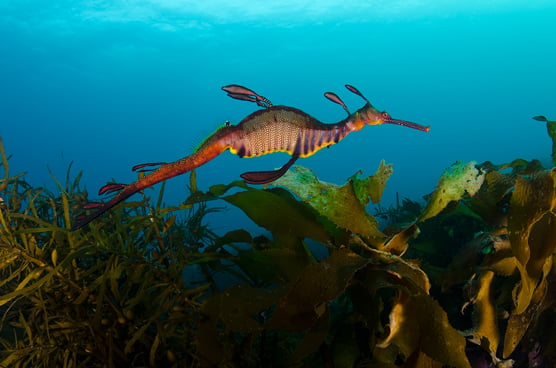 Source: Sheree Marris—shereemarris.com
Source: Sheree Marris—shereemarris.comWeedy sea dragon off the southern coast of Australia.
As quickly as kelp forests grow, they can be destroyed. Global warming is a huge problem. Other threats include pollution, overfishing, invasive kelp species, and voracious sea urchins. A group of sea urchins can destroy entire kelp forests at a rate of 30 feet per month. Fortunately, urchins are a delicacy to sea otters, which eat 20 to 30 percent their body weight in food every day. Unfortunately, sea otters are facing their own challenges — from not enough fish to eat and increased pollution to human related disease and even poaching.
The absolute cutest activity that takes place in kelp forests (and maybe in the entire ocean) is this: Sea otters wrap their babies in kelp so they don’t drift away while the mother hunts or takes a well-deserved nap.
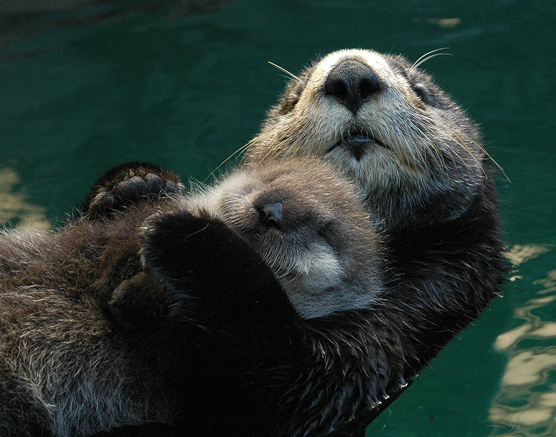 Lootas and pup. Source: C.J. Casson, Seattle Aquarium
Lootas and pup. Source: C.J. Casson, Seattle AquariumToo cute—mother and baby sea otter.
Swirling in Sargasso: A Sea without Borders
The Sargasso Sea is an area in the Atlantic Ocean where vast mats of a unique brownish-gold seaweed called sargassum live. Like kelp, sargassum has gas-filled bladders that make it float. Unlike kelp and other seaweeds, it’s holopelagic, meaning it spends its whole life (“holo”) floating in the pelagic zone (the water column) without needing contact with any land form and reproducing vegetatively (new plants grow from fragments of parent plants). Pretty cool, huh? The Sargasso Sea is also the only sea without a land boundary.Sargassum gathers in and around the North Atlantic Gyre, a huge, swirling body of water off the eastern coast of the United States that spins due to ocean currents. These swirling currents concentrate the sargassum into enormous mats (called windrows), which can be hundreds of meters long. Based on satellite images, scientists estimate the biomass in the Sargasso Sea to be around one million tons.
The Sargasso Sea is an oasis in the open ocean for all types of creatures, including sea turtles, whales, sharks, fish, crabs, snails, octopus, squid, worms, shrimp, nudibranchs, and more. Some animals are specially adapted to live among this floating haven, such as the iconic Sargassum Angler Fish, which not only blends into the surroundings but also has special fins that enable it to climb through the seaweed (see figure).
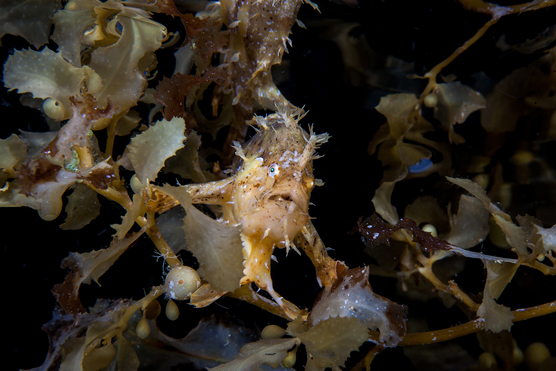 Source: Ethan Daniels / Shutterstock
Source: Ethan Daniels / ShutterstockThe Sargassum Angler Fish.
However, while some creatures spend their whole life in the sargassum, others just take a break while passing through. The most famous of these are sea turtles. After emerging from their nests, sea turtles scurry down the beach into the ocean. In the Atlantic, many species of sea turtles then swim as fast as they can out into the Sargasso Sea to spend their early years hiding amongst the relative safety of the sargassum mats before they are big enough to venture out again into the open ocean.
Grazing in the Seagrass Meadows
Unlike kelp and sargassum (both seaweeds) seagrass is a bona fide plant, complete with a vascular system (a network of veins to move nutrients and dissolved gases throughout the plant). In fact, it’s the only angiosperm (flowering plant) in the ocean. The flowers are usually borne underwater, and pollination occurs underwater as well (in most cases). Seagrass also has a true root system, as opposed to a simple holdfast like kelp. The root system anchors the plant to its substrate and acquires nutrients for the plant as well. Similar to lawn grass, sea grass roots commonly send out rhizomes (underground shoots that sprout more grass). This root/rhizome system creates a dense, interwoven mat that holds the grass and seafloor in place, thereby literally anchoring the entire ecosystem.Seagrass can be found nearly everywhere in the world except Antarctica. It grows in both salty and brackish water as long as the water is shallow and can vary in size from small mats to enormous meadows that resemble fields of underwater wheat. Botanists estimate that globally these sea grass fields produce more vegetation than all the wheat fields of the U.S. grain belt combined. Some of these fields are even large enough to be seen from space!
Seagrass fields are extremely important in providing nursery and adult habitat and feeding grounds for many species, from small invertebrates all the way up to turtles, birds, crabs, and large fish. Most seagrass grazers use the broken up and degrading leaves as their food source. Others, such as the sea turtle, the manatee (see the following figure), and its relative the dugong, eat the entire plant — and a lot of it, too. One large, hungry manatee can gulp down almost 100 pounds of seagrass a day!
In addition to providing food and shelter, the seagrass helps reduce erosion, filter water, release oxygen into the water, and extract and sequester carbon dioxide. With all these benefits, seagrasses are thought to be one of the most valuable ecosystems in the world, just behind coral reefs, estuaries, and wetlands. One hectare of seagrass (about two and a half acres) is estimated to be contribute over $19,000 per year of value to the global economy.
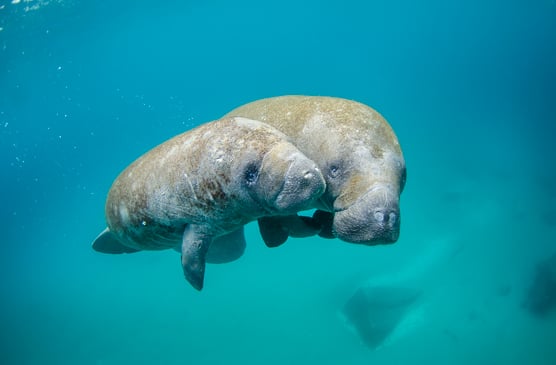 Source: Sam Farkas, NOAA OAR Photo Contest 2014
Source: Sam Farkas, NOAA OAR Photo Contest 2014Manatee and calf.

